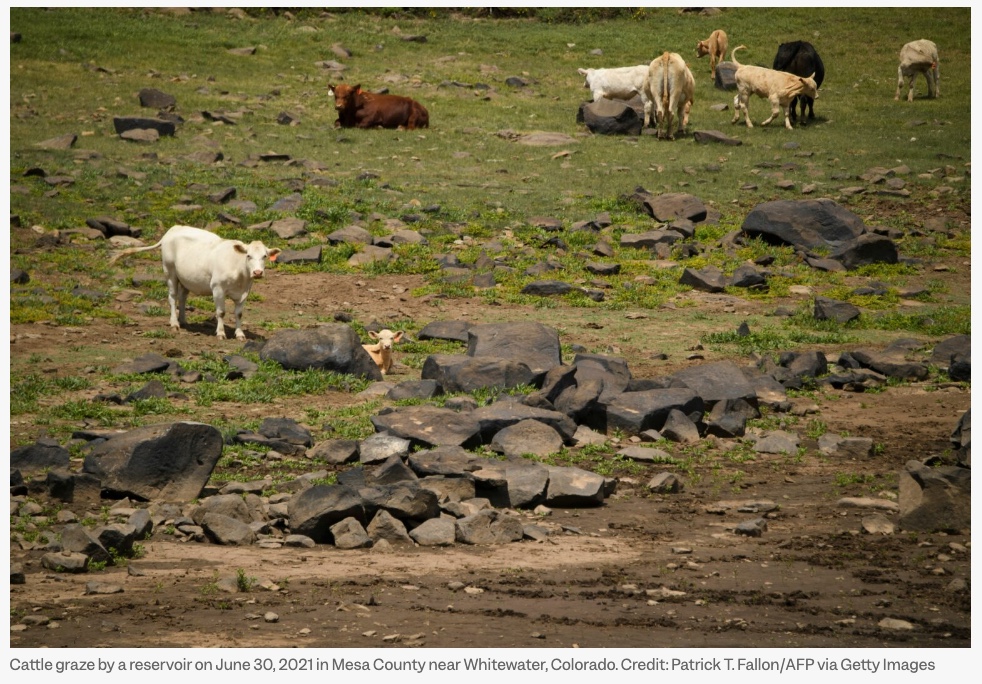Yet another article detailing how the cattle industry is destroying soil and wildlife habitat in the American West — and accelerating the climate crisis by heating the planet.
READ FULL ARTICLE.
Some EXCERPTS:
• Cattle are well known emitters of methane, through belching and manure. But in the arid and fragile West, they’re also destroying an important carbon sink, largely by churning up soil and vegetation, scientists say. This is happening, some research says, in a kind of vicious cycle, where the effects of grazing are heating a landscape that’s already becoming hotter and drier.
• “We’re in a climate emergency,” said Tim Whitehouse, PEER’s executive director. “Grazing has been a third rail at BLM. It’s a program they don’t want to touch. They don’t want to address the consequences of overgrazing, or for that matter, understand them.”
• Livestock grazing, mostly by cattle, is the single largest use of publicly owned lands in the West, and nearly all of that grazing is authorized by the BLM and the Interior Department’s Fish and Wildlife Service. The BLM issues 18,000 grazing permits, covering 21,000 allotments across 155 million acres in 13 states—an area the size of California and Oregon combined. Though the department doesn’t release a head count, researchers and advocacy groups say those permits represent about 1.5 million heads of cattle.
• “The primary cause of desertification in the arid lands of the West, whether on public or private lands, has been livestock grazing and continues to be so,” said J. Boone Kauffman, a professor in the the department of Fisheries, Wildlife and Conservation Sciences at Oregon State University. “It’s irrefutable. Grazing on public lands has resulted in soil carbon loss, and at the same time we’re seeing lower water holding capacity, less root mass to actually exploit the available water, a loss of species—all of these are exacerbated by the impact of climate change. In other words, we’re accelerating the impact of climate change and we’ve shifted these rangelands from net sinks to net sources of greenhouse gas emissions.”
• In a paper published in April, Kaufmann and his colleagues found that grazing on public land in the West emits 12.4 million metric tons of carbon dioxide equivalent a year —roughly the emissions of 3.3 million passenger vehicles.
EXCERPT from Kaufman’s Oregon State University study cited above: About 85% of public lands in the western USA are grazed by domestic livestock, and they influence climate change in three profound ways: (1) they are significant sources of greenhouse gases through enteric fermentation and manure deposition; (2) they defoliate native plants, trample vegetation and soils, and accelerate the spread of exotic species resulting in a shift in landscape function from carbon sinks to sources of greenhouse gases; and (3) they exacerbate the effects of climate change on ecosystems by creating warmer and drier conditions. READ STUDY: https://link.springer.com/article/10.1007/s00267-022-01633-8
• “…they’re [ranchers] paying the federal government… less than you’d pay to feed your goldfish,” said John Janicek, a Dallas-based attorney who has written about the impacts of the grazing program on climate change. “The agencies are running these programs at $100-million-plus deficits, all the while, in my opinion, deteriorating the rangeland.”
• Critics say this means taxpayers are subsidizing a program that’s a bad deal financially and environmentally, and as PEER writes in its letter, is “designed to magnify rather than minimize adverse climates impacts on these rangelands.”
• The data show that more than 1/2 of BLM-managed land failed the agency’s own standards for land health and indicate that grazing is a significant cause of degradation on nearly three-quarters of that land. The data also show that the agency has not yet evaluated more than one quarter of its grazing land, or 41 million acres.
READ FULL ARTICLE.
(If hyperlink above doesn’t work, copy-and-paste this: https://insideclimatenews.org/news/25072022/the-bureau-of-land-management-lets-1-5-million-cattle-graze-on-federal-land-for-almost-nothing-but-the-cost-to-the-climate-could-be-high/ )


